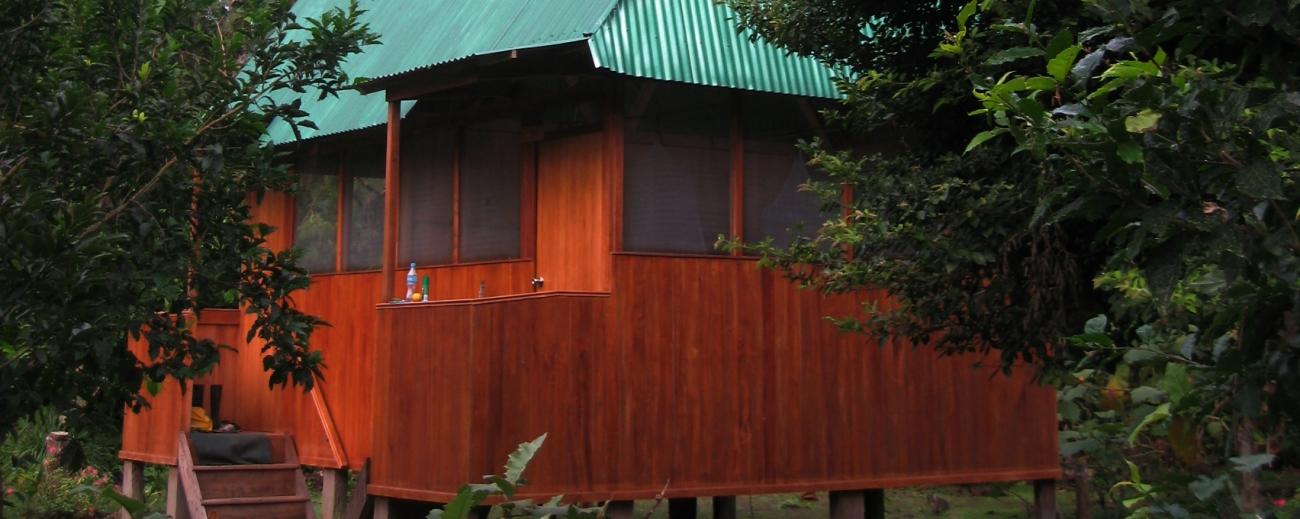Rainforest Lodge
It is located on the rights side of the Manu road, from Cusco 190 km driving by bus, located at 600 meters above sea level; basically at the foothill of the Andes, near to the town Patria and Pilcopata, the lodge is wooden made with local material from the area, consisting on great designed bungalows with a total of 10 double rooms, 3 twins bungalows with private bathroom giving a maximum capacity of 25 people, we have a new communal restrooms. Paths lead from Bungalows to Bathrooms, recently built a new dining area spacious and comfortable and a hummingbird garden at the surrounded (feeders). It is possible to accommodate in triple beds. All beds have the Mosquito net, all bungalows are covered with nets too.
Bonanza Lodge
Located at the right side of the watershed of Madre de Dios River, the land is part of the Amazonian lowland basin at 300 meters above sea level; this lodge is adjacent to Manu National Park. The lodge is wooden made of finest furniture. There are 10 double rooms, 2 bungalows with 4 double rooms with private bathroom, giving a maximum capacity of 25 people, Bonanza Lodge has an ECO-Bathroom system that makes sustainable and friendly with the environment, triple beds are available according to request, book in advance for this service.
Bonanza Lodge is a private reserve area, run by William´s parents, (Huamani-Choquepuma Family) the forest is most pristine jungle offering a great opportunities to see animals, an excellent place for birders, naturalist photographers, researchers, and for scientific studies of animals, this is an unique area with different types of habitats like River-Edge Forest, Second Growth Forest, Marsh, Bamboo Forest, Primary and Terra Firme Forest, and it offers a comprehensive trails systems (Trochas), and great wildlife watching. Bonanza Lodge has about 750 hectares of land, providing access to our private Mammals Clay Lick-Tapir Clay Lick.
Casa Matsiguenka
The project was initiated in 1996, by the native communities of Yomibato and Tayakome, in conjunction with a non-government organization from Germany, to establish a rustic lodge based on Matsiguenka style construction near the Cocha Salvador area. Accommodations are simple rooms with beds and mosquito nets, there are also private bathroom bungalows made with rustic staffs and a large communal dining room. More than adequate toilet and shower facilities are on hand. The object of this project is to give the visitor the opportunity to learn about and understand not only the natural wonders of Manu; but also the cultural history and traditions of its inhabitants.
In 1999 Casa Matsiguenka Lodge received its first guests, but there is still much to be done before the full potential is realized and the aims and dreams of these quiet, gentle people to become included in, and benefit from, the attraction that Manu offers, are achieved. This after all, is their home. For this reason, Amazon Wildlife Peru, in agreement with the Matsiguenka communities, uses the Casa Matsiguenka Lodge. This agreement means the visitor will benefit in experiencing an aspect of the magic of Manu; they otherwise would not have been exposed to. At the same time, they will be assisting in an essential aspect of the long-term preservation of Manu and helping native Amerindian communities, enter the ever-shrinking world without losing their cultural values. Amazon Wildlife Peru`s guides will have the help of local Matsiguenkas on future trips so that we can learn from these indigenous peoples and benefit from their encyclopedic knowledge of medicinal plants and other wonders. In return, the Matsiguenkas will get to learn something about us, our culture and learn the language skills necessary if they are to take visitors into their forest.
Observation Towers
Amazon Wildlife Peru offers you the unique chance to watch wildlife from their two brand new observation towers located in the Bonanza Ecological Reserve. The towers at Bonanza are a great alternative for wildlife observation like canopy birds, and monkey species.
We, Amazon Wildlife Peru, together with Bonanza Tours, have recently completed the construction of two Metal made observation towers at our own and save land: in the Bonanza Ecological Reserve. One of the towers is located only a few minutes walk from the Bonanza Lodge, in the transitional, Bamboo forest, this bird watching tower height of 20 meters stands and offers our guests the stunning opportunity to observe the rainforest's bird life including toucans, macaws, colorful barbets, oropendolas and many species.
The other tower is 20 meters high and located on a rivers edge forest, at 40min walk away from the lodge, showing extend side of a meandering river. From the top of the platform, you can observe many animals crossing the dry beach of the river, such as peccaries, anteaters, agoutis, and if you are lucky you can even see jaguars and pumas (higher chances during the dry season).
Tapirs Clay Lick
This place is built in the hearth of the forest, from Bonanza Lodge takes 2 hours walking, mostly flat-trail. The structure is basic, and wooden made platforms, with 20 meters long, 6 meters of height, secured with wooden railings, wooden stairs with fixed handrails, this construction is very solid, from where we see animals during the night, and in front of it we have the salt-lick-muddy pool, bathroom service is not available.
Scientifically named geophagy, eating material directly from the earth is quite common and researchers have listed many animals behaving in this way. It has long been known that birds species, monkeys species, Tapirs and many other animals eat different types of clay. These various clay licks contain different chemicals, and an important chemical is a salt. Salt is vital for all animals to maintain a healthy nervous system as well as a healthy heart and muscles. This may be an additional explanation for the common although strange behavior. Frequently seen in documentaries, tapirs are a classic example of animals eating clay. They will go to great lengths to reach clay licks and either eat it, or cover themselves with it. Tapirs will track back to certain specific sites, suggesting they are looking for some particular chemical. Other records include monkeys eating termite mounds (containing clay as a major component). A suggestion for why they did this was to detoxify something they had eaten.
Toxins found in the fungus growing on some plants can cause numerous health problems like decreased milk and egg production, liver damage, and a lowered immune system. Clays have been suggested to neutralize these toxins so the animal can continue eating plants without side effects. When we look at animals engaging in this seemingly bizarre behavior, we can understand the activity by looking at our own behavior and medical history. It seems that many animals, including humans, have an ingrained or cultural knowledge for obtaining the many essential chemicals we require.


